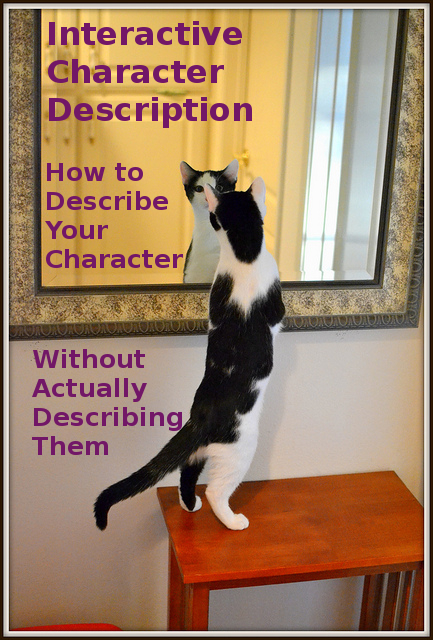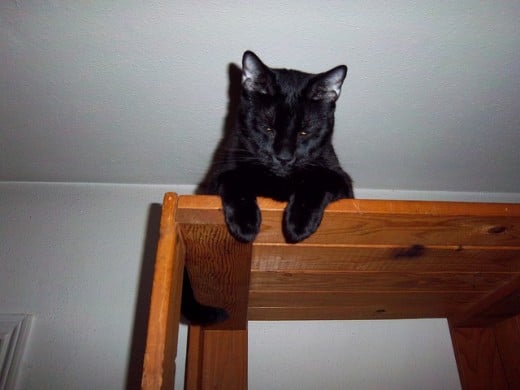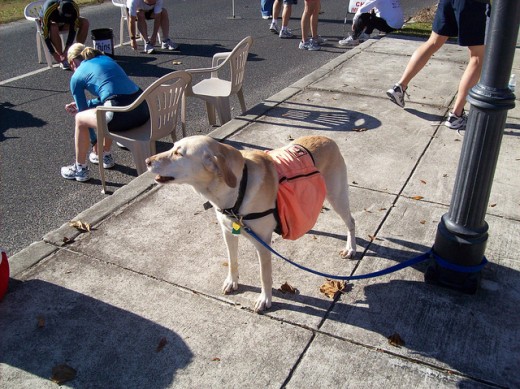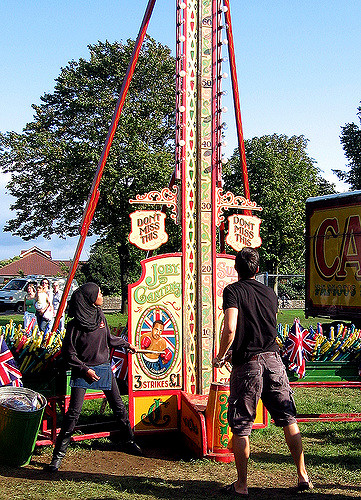Interactive Character Description - Beyond the Mirror

Some time back I wrote Not the Mirror Again! where I talked about ways of describing your character without having them do the cliche "look in the mirror" thing.
Today I thought I'd look at some techniques for describing your characters without describing them at all.
Now I'm not suggesting that you shouldn't let your readers see your characters features or hair color. You absolutely can.
The tricks I'm writing about are a bit more subtle, and allow your reader to know something about your character without even realizing they're reading a description.
Lets play a game. I'll give you seven examples. You tell me something about the character in each.
1. Sebastian ducked under the door frame and stepped into the motel room.
2. Martha got a stepstool and went in search of the jar of currant preserves that she'd seen Rolf put in the top cabinet.
3. Jabbing his cane at the ground beneath the peony bushes, Dougherty let loose a string of expletives.
4. Sophie put down her cigarette holder and fished a lorgnette from her purse to peer at Ellis. She twisted the diamond-encrusted ring around her finger.
5. Carter nailed the gas on his rust-bucket and roared through the gate. The car touched down perfectly in the center of the Davidsons' in-ground pool.
6. Fiona blushed at the wolf whistles from the guys in front of the candy store.
7. Terry looked up at the woman and took a cookie from the plate she held out. "Thank you, Mrs. Ornstedder."
Nowhere in these sentences have I given any description of my characters, but I'll bet you got the answers right.


Interactive Description Requires Trusting Your Reader
The three methods I've used in the above examples are description through interaction with the environment, interaction with props and through interaction with other characters.
One of the things we're going to rely on in these, is the principle of trusting in the reader. Assume that your reader is smart and that they know myriad facts about the world. They might never have been to London, but they've probably seen a picture of Big Ben. Even if they've never been to Africa, they almost certainly know that's where lions come from.
And even more important, they've reacted with the world around them. Unless they've been paralyzed since birth they've opened doors, know the difference between the feel of grass under their feet versus sand. They've taken things out of cabinets, thrown clothes into the washer or stepped into a shower.
Even if they somehow haven't done all these things, they've seen others do them.
Lets use Sebastian as our first example.
Most doors are a standard height, and the reader know this. So the fact that Sebastian has to duck under the door frame tells us that he's taller than average. Yes, it's possible that we're dealing with a shorter-than-average door, but in the absence of the writer telling us so, we assume that the door is normal and it's Sebastian who's other-than-normal.

Description through Interaction with the Environment
I'll bet you guessed that Martha is short.
It's possible that Rolf stashed the preserves in a high place because he didn't expect to need them soon, or he wanted to make it hard for Martha to reach them. It's more likely that he's taller than she is. My taller-than-me husband is often putting things on high shelves where I have to struggle to reach them.
If you want to show that your character is weak, have them struggle to open a door handle, or to make it up the stairs.
If you want the reader to see your character as strong, give them a large, heavy object which they can heft with ease.
If the character races down the stairs, they're probably young. They might be worried. They could be excited. They could be racing to get the phone. Unless they're being chased by an axe murderer, they're probably not frail or elderly.
Description Through Interaction With Props
Props are a subset of the environment. Unlike many environmental factors, props don't always come in standard sizes, so they won't always give us information on our character's size. They can often tell us about the other factors which may be far more personal.
Since Dougherty walks with a cane we know that he is either elderly or has some sort of leg injury. (Unless his story takes place in an era when all gentlemen carried a cane.) You might also guess that he likes flowers and that he has a temper.
Sophie has a cigarette holder, a lorgnette and a diamond-encrusted ring. From this, we can guess that she's wealthy, and quite possibly pretentious. The fact that she needs to use the lorgnette to look at Ellis suggests that she's nearsighted. The way she twists the ring on her finger tells us that Ellis might be making her nervous.
How your characters react with the props around them tells us not only about the sort of items they surrounds themselves with, but also gives us insight into their mental state.
Does she push the button on the elevator, or stab it? Does he hand his secretary the folder, toss it in her inbox or slam it down on the desk?
The specific nouns we use when describing the environment and props also tells us something about the characters. If Sophie had bifocals or just glasses, we would get a slightly different image than with the lorgnette.
The fact that Carter drives a rust-bucket while the Davidsons have a gate and an in-ground pool, suggests that there's a wealth inequity which may be part of the problem between them. Try substituting a Porsche for the rust-bucket, or an above-ground pool for the in-ground one. Have Carter smash through the wall of a tavern or a grocery store or a car dealership window or a picket fence, and you immediately have a different picture of who these people are and what might be going on.
The props that your characters surround themselves with can also tell us what makes them different. Consider the cowboy with a framed law degree in his tack room. Or the construction worker reading Shakespeare's sonnets on his lunch break. Or the cardiac surgeon with, Achey Breaky Heart playing on his radio.

Do you use Interactive Description in your writing?
Description Through Interaction With Other Characters
The fact that Fiona gets wolf whistles from the guys in front of the candy store lets us know she's probably attractive. Since she blushes, we can also assume that she's a bit shy.
Terry looks up at Mrs. Ornstedder, so we know that he's either seated or shorter than she is. When he addresses her by her title and last name, we can guess that he's a child and she's an adult. (To be fair, I didn't state that Terry's a boy until now, but that's how I imagined him.)
We'd get an entirely different impression of Terry if he said, "thank you madam," or "thank you miss," or (back to props) if she had offered him a scotch.
Right now you might be thinking that Terry's a pretty well-behaved boy. What if he'd waved her off? If he just grabbed a cookie without saying thank you? If he'd said, "Give me the damned cookies, bitch."?
If your character comes to attention when someone enters the room, then he probably perceives the other person as an authority figure, and its also likely that your character has had some military background.
If that same person comes into the room and your character puts his feet on the desk, then we know your character is comfortable in their presence, and maybe disrespectful, depending on who the desk belongs to.
On meeting someone for the first time, does your character shake their hand, give them a hug, give them a European-style air-kiss on each cheek, bow or thrust their fist into their pocket? Each option will say something different about your character.
Which method of character interaction was most fun or meaningful to you?
An Interactive Description Exercise
Using one of the three interaction techniques, write a sentence or two that shows us something about each character without using any description.
Mary is frightened.
Ted is elderly and infirm.
Eleanor is in a wheelchair.
Bobby is three years old.
Jones is contemptuous of Alfred.
Liz wants to get in Harry's pants.
Tucker is an artist.
Sam is melancholy.
Beth is rail thin.
Tina is an athlete.
For "extra credit" you can try each example in all three interactive modes.
This article was originally published on NakedWithoutAPen 2/27/2011








